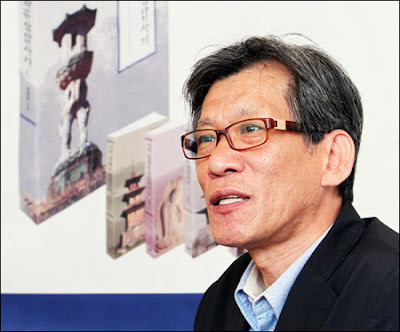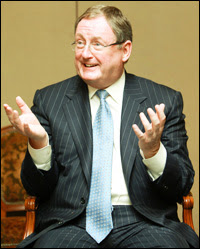
I have taken out this article from the Korea Times (rediscovering Korean history section) as this articles will give insight to the viewers and students of Korean language as well as area studies students.More resources on Korean history can be found in the books section,
on sale at Amazon.
This is the first of a 10-part series on Korean history from its mythological, ancient beginning until the present day. This project is sponsored by several companies and public agencies including Merck Korea, eBay Korea, Daewoo Securities and Korea Post according to The Korea Times.
(Dr. Kevin N. Cawley is currently the Deputy Director of the Irish Institute of Korean Studies at University College Cork (UCC), Ireland — the only institute in Ireland dedicated to promoting Korean studies — funded by the Academy of Korean Studies, South Korea. He was previously a Gyujanngak Fellow at Seoul National University).
So let's begin from "Dangun" ― The Legendary founder of Korea
The Lord of Heaven had a son called Hwanung, who wanted to live on Earth. His father allowed him to leave Heaven, and sent with him some 3,000 followers including “ministers” taking charge of the wind, clouds and rain.
At that time, a tiger and a bear prayed to Hwanung to make them human. Hwanung set them a task: to live in a cave, away from the sunlight, for 100 days, and to eat just garlic and mugwort.
Before long the impatient and hungry tiger gave up and left the cave, but the bear stayed, and after 21 days turned into a woman. Soon she married Hwanung and later gave a birth to a boy named Dangun, who became the first ruler of Korea.
King Dangun founded Korea’s first kingdom called Gojoseon and governed the country, which controlled areas in today’s far-east China, north of the Korean Peninsula for around 1,500 years. The legend states that Dangun, the grandson of Heaven, became a guardian spirit of a mountain at the age of 1,908.
It may be hard to believe that these things really happened, but many historians think that the Dangun myth contains clues to understanding the earliest society on the Korean Peninsula.
In other words, the Dangun story tells us that the earliest Koreans were religious and worshipped all aspects of nature. One tribe worshipped the sky or Heaven, while other tribes worshipped the tiger and the bear. Eventually the Heaven tribe, which must have been very powerful and smart, united with the bear tribe and drove away the tiger tribe. Dangun is regarded as the official title of their leader, who also had a religious role in his community.
Some go even further ― there are a small group of Koreans who admire Dangun as a god and follow a religion founded in 1909 just before Korea was colonized by Japan. It remains a very minor belief compared to other mainstream religions in Korea such as Christianity and Buddhism.
Historically speaking, the Dangun myth has helped unite Koreans and highlights their unique origins. It also shows that their history and identity is very different from that of neighbors China and Japan, who throughout history invaded the country.
Whether or not people believe in Dangun, his traces are everywhere. For one, October 3 is a national holiday in Korea, as Dangun is thought to have founded the country on the date in 2,333 B.C. In addition, the story of Dangun has even influenced the world-renowned Korean martial art Taekwondo.
The second pattern in the ITF (International Taekwondo Federation) form is named Dangun, and is composed of a series of high-section punches at eye level. This represents the connection between Dangun, Heaven and the mountain where became a mountain spirit.

The first kingdom: Gojoseon
While there are many controversies about Dangun’s real identity, there are no doubts that Gojoseon was Korea’s first kingdom and that it extended into much of Manchuria and the northern part of the Korean Peninsula. The oldest historical records have come up with somewhat different accounts for the date of the foundation of the country, but 2,333 B.C. is officially accepted.

This period corresponds with the transition period between the Bronze and Iron ages. Hence, Koreans take pride in the fact that their country’s origin dates back almost 4,500 years. Until the early 1960s, South Korea officially used the Dangun Era calendar on its coins and postage stamps.
Along with Gojoseon, there existed some other states but they were annexed by Gojoseon to make it a powerful country, which could withstand its rivals from mainland China and even expanded its territory well into Manchuria. In the early 2nd century B.C., Gojoseon took refugees from the Yan state in eastern China but they returned evil for good by rebelling and taking the throne. Debates are still underway as to whether the leader of the refugees was an ethnic Korean or not.
In any case, the new Gojoseon ruled by Yan refugees failed to last a century as it fell in 108 B.C. after wars with China. Gojoseon took an early victory against the enemy’s two-pronged strategy, one by land and one by sea, but eventually it collapsed.
In line with the Dangun legacy, the people of Gojoseon worshipped Heaven, held sacred rites and practiced customs that were shared by other Northern states established by ethnic Koreans. Their traditions and culture were passed down to successor states.
Gojoseon had a very strict legal system which consisted of eight clauses. For instance, murderers were to be killed while thieves were to become slaves, and anyone who hurt another was to offer grain to be forgiven.
Southern states
South of the Han River, there existed scores of small city states, which formed three main unions around 2,300 years ago. They survived and thrived there for quite a long time thanks to the natural defenses provided by this great river at the heart of the Korean Peninsula. They were no match for Gojoseon, but flourished enough to trade with various Chinese states.

Just as the northern states, including Gojoseon that worshipped Heaven, the southern countries also held religious rituals conducted by shamans at sacred places such as mountains. Some areas were marked by tall wooden totem poles to show the belief that nature was controlled by spirits.
We also know that ancient Koreans had special rituals for those who died considering the large number of large stone Dolmen tombs ― in fact there are more such in Korea than anywhere else.
With the weakening of Gojoseon, and with the development of strong states south of the Han River, the Korean Peninsula and Manchuria saw three strong states rise to form a three-way rivalry for several hundred years.
















































